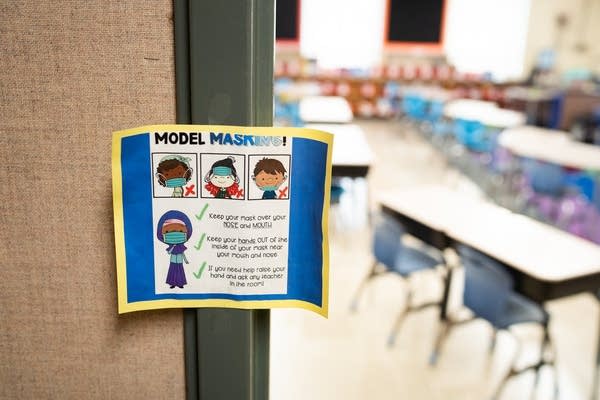Minnesota elementary schools can reopen Jan. 18
Every grade school across the state can choose hybrid or in-person learning if they implement certain safety measures

Like this?
Log in to share your opinion with MPR News and add it to your profile.
Like this?
Thanks for liking this story! We have added it to a list of your favorite stories.
Updated: Dec. 17, 6:33 p.m. | Posted: Dec. 16, 3:05 p.m.
Gov. Tim Walz is giving elementary schools across the state the green light to reopen Jan. 18 if they adopt a number of strategies to contain the spread of the coronavirus.
The announcement Wednesday is a departure from Walz’ earlier plans, which required K-12 districts to rely on county-level data and consultations with local health officials regarding the level of virus transmission in their communities.
With the loosened restrictions, every early childhood program and grade school in Minnesota can choose to resume in-person or hybrid learning models as long as they implement safety measures, regardless of county case rates. The precautions include regular COVID-19 testing of staff and requiring them to wear a face shield and mask.
“The desire to get those children back in the classroom is so intense,” said Walz, a former school teacher.
Support the News you Need
Gifts from individuals keep MPR News accessible to all - free of paywalls and barriers.
The governor is not requiring schools to open, however. Local school districts will make that decision, and parents can still opt for full-time distance learning.
Some school administrators say it’s too soon to tell how many districts will actually be able to meet the necessary safety and staffing requirements.
“We’re gonna have to see how we come out of the winter break and what the spread is,” said Scott Croonquist, executive director of the Association of Metropolitan School Districts. “But I certainly think that it’s consistent with what our school leaders were hoping to do. Returning to some in-person instruction, especially for our elementary students, is a high priority.”
Parents who still want to keep their students in distance learning will be able to do so, according to the new guidance.
A day after the governor’s announcement, St. Paul Public Schools on Thursday said that the district plans to welcome its youngest students back for in-person learning starting Feb. 1. The rolling start will begin with prekindergarten through second grade, and families will need to choose between in-person instruction and distance learning, Superintendent Joe Gothard said. There will be no hybrid option.
When announcing the new plan, Walz cited research showing the youngest children are less susceptible to the most devastating effects of COVID-19.
Schools that want to transition students to in-person or hybrid learning will be required to implement a rolling start, with the littlest learners going back into the classroom first. For example, a district may decide to allow K-2 students into school buildings Jan. 18 to 29. The following two weeks, Feb. 1 to 15, the schools can also reopen their doors to grades 3 through 5.
Some highlights of the new plan include:
A COVID-19 testing program that gives staff the option to test for the virus every other week
3 feet of physical distancing or more is strongly recommended for full-time in-person learning
Students will need to mask up during physical activities that take place inside, including gym class or during indoor recess.
School staff must wear face masks and face shields at all times.
“This plan prioritizes the health, well-being, and education of our students, while taking precautions to protect the teachers and staff who care for them, so we can begin to help them make up for lost time,” said Lt. Gov. Peggy Flanagan in a statement. “The best place for our students to learn is in the classroom. For our youngest learners, in-person learning is critical for their health and development in both the short and long term.”
But for state Republican leaders, the phased-in return of students to the classroom isn’t coming soon enough.
“The science and data are clear: kids need to be back in school now and it will be safe. Being out of school has done great harm to our kids and every day they are not in school it gets worse,” said Sen. Roger Chamberlain, R-Lino Lakes, who is the incoming chair of the Senate education committee. “The governor's proposal includes only K-6 and it could take nearly two months to execute.”


